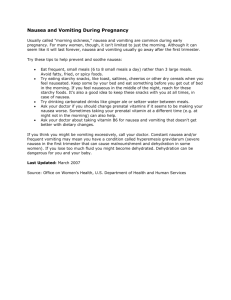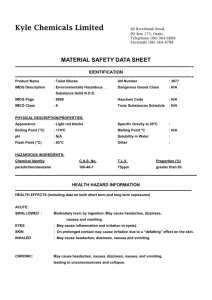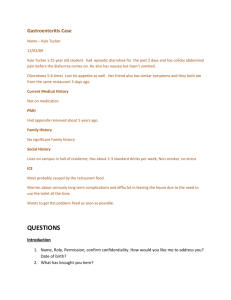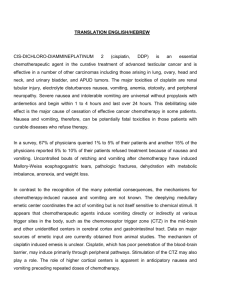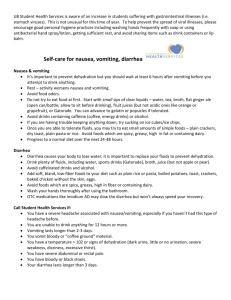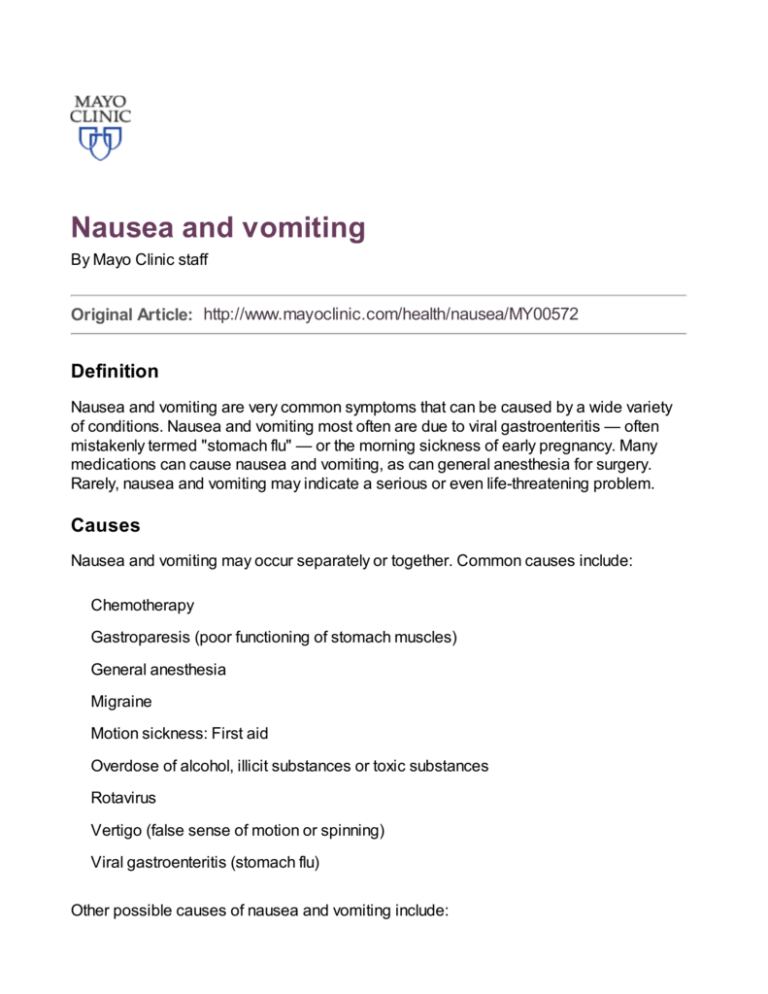
Nausea and vomiting
By Mayo Clinic staff
Original Article: http://www.mayoclinic.com/health/nausea/MY00572
Definition
Nausea and vomiting are very common symptoms that can be caused by a wide variety
of conditions. Nausea and vomiting most often are due to viral gastroenteritis — often
mistakenly termed "stomach flu" — or the morning sickness of early pregnancy. Many
medications can cause nausea and vomiting, as can general anesthesia for surgery.
Rarely, nausea and vomiting may indicate a serious or even life-threatening problem.
Causes
Nausea and vomiting may occur separately or together. Common causes include:
Chemotherapy
Gastroparesis (poor functioning of stomach muscles)
General anesthesia
Migraine
Motion sickness: First aid
Overdose of alcohol, illicit substances or toxic substances
Rotavirus
Vertigo (false sense of motion or spinning)
Viral gastroenteritis (stomach flu)
Other possible causes of nausea and vomiting include:
Addison's disease
Alcoholic hepatitis
Anaphylaxis
Anorexia nervosa
Appendicitis
Benign paroxysmal positional vertigo (BPPV)
Brain AVM (arteriovenous malformation)
Brain hemorrhage
Brain infarction
Brain tumor
Bulimia nervosa
Chronic kidney failure
Congenital adrenal hyperplasia (condition that limits adrenal function)
Crohn's disease
Cyclic vomiting syndrome
Depression (major depression)
Diabetic ketoacidosis
Dizziness
Ear infection (middle ear)
Food poisoning
Frontal lobe seizures
Gallstones
Generalized anxiety disorder
GERD
Head injury
Heart attack
Heart failure
Hirschsprung's disease
Hydrocephalus
Hyperparathyroidism (overactive parathyroid)
Hyperthyroidism (overactive thyroid)
Hypoparathyroidism (underactive parathyroid)
Intestinal ischemia
Intestinal obstruction
Intracranial hematoma
Intussusception (in children)
Irritable bowel syndrome
Liver cancer
Liver failure
Meniere's disease
Meningitis
Milk allergy (in infants and children)
Nonulcer stomach pain
Pancreatic cancer
Pancreatitis
Peptic ulcer
Porphyria
Pseudotumor cerebri
Pyloric stenosis (in infants)
Radiation therapy
Retroperitoneal fibrosis
Social anxiety disorder (social phobia)
Stomach obstruction
Strep throat (in children)
Temporal lobe seizure
Traumatic brain injury
When to see a doctor
Call 911 or emergency medical assistance
Seek prompt medical attention if nausea and vomiting are accompanied by other
warning signs:
Chest pain
Severe abdominal pain or cramping
Blurred vision
Fainting
Confusion
Cold, clammy, pale skin
High fever and stiff neck
Fecal material or fecal odor in the vomit
Seek immediate medical attention
Ask someone to drive you to urgent care or the emergency room if:
Nausea and vomiting are accompanied by pain or a severe headache, especially if
you haven't had this type of headache before
You're unable to eat or drink anything for 12 hours or your child hasn't been able to
keep liquids down for eight hours
You have signs or symptoms of dehydration — excessive thirst, dry mouth,
infrequent urination, dark-colored urine and weakness, dizziness or
lightheadedness upon standing
Your vomit contains blood, resembles coffee grounds or is green
Schedule a doctor's visit
Make an appointment with your doctor if:
Vomiting lasts more than two days for adults, 24 hours for children under age 2 or
12 hours for infants
You've had bouts of nausea and vomiting for longer than one month
You've experienced unexplained weight loss along with nausea and vomiting
Take self-care measures while you wait for your appointment with your doctor:
Take it easy. Too much activity and not getting enough rest might make nausea
worse.
Stay hydrated. Take small sips of cold, clear, carbonated or sour drinks, such as
ginger ale, lemonade and water. Mint tea also may help.
Avoid strong odors and other triggers. Food and cooking smells, perfume,
smoke, stuffy rooms, heat, humidity, flickering lights, and driving are among the
possible triggers of nausea and vomiting.
Eat bland foods. Start with easily digested foods such as gelatin, crackers and
toast. When you can keep these down, try cereal, rice, fruit, and salty or highprotein, high-carbohydrate foods. Avoid fatty or spicy foods. Wait to eat solid foods
until about six hours after the last time you vomited.
Use over-the-counter (OTC) motion sickness medicines. If you're planning a
trip, OTC motion sickness drugs, such as Dramamine or Rugby Travel Sickness,
may help calm your queasy stomach. For longer journeys, such as a cruise, ask your
doctor about prescription motion sickness adhesive patches, such as scopolamine
(Transderm-Scop).
If your queasiness stems from pregnancy, try nibbling on some crackers before you get
out of bed in the morning.
References
May 14, 2011
MY00572
© 1998-2012 Mayo Foundation for Medical Education and Research (MFMER). All
rights reserved. A single copy of these materials may be reprinted for noncommercial
personal use only. "Mayo," "Mayo Clinic," "MayoClinic.com," "EmbodyHealth,"
"Enhance your life," and the triple-shield Mayo Clinic logo are trademarks of Mayo
Foundation for Medical Education and Research.


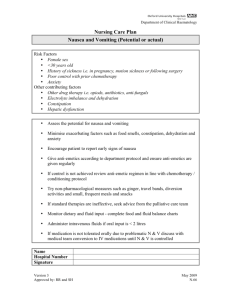
![[Physician Letterhead] [Select Today`s Date] . [Name of Health](http://s3.studylib.net/store/data/006995683_1-fc7d457c4956a00b3a5595efa89b67b0-300x300.png)
